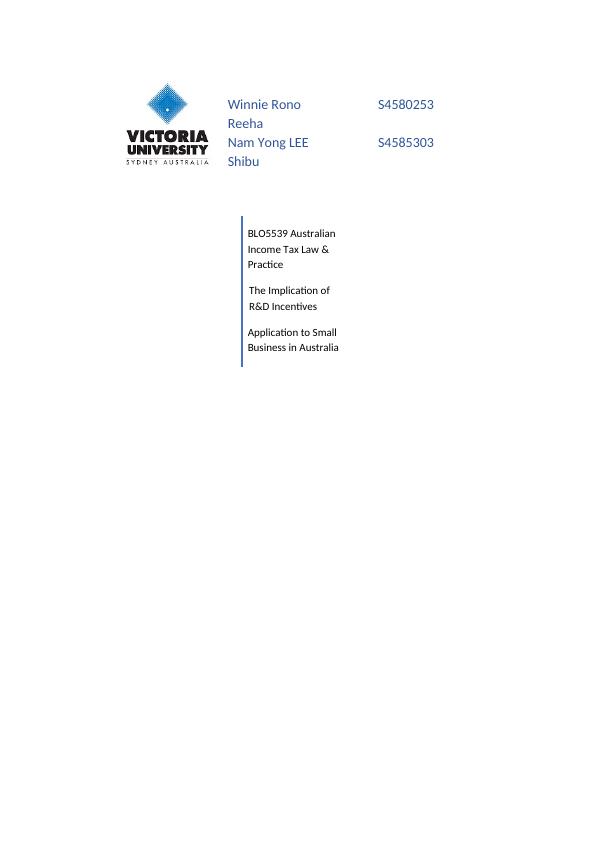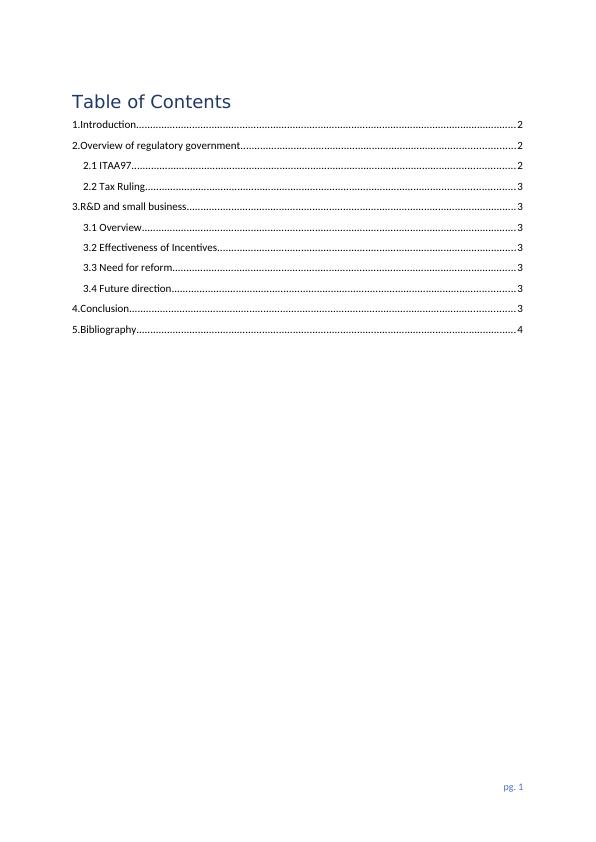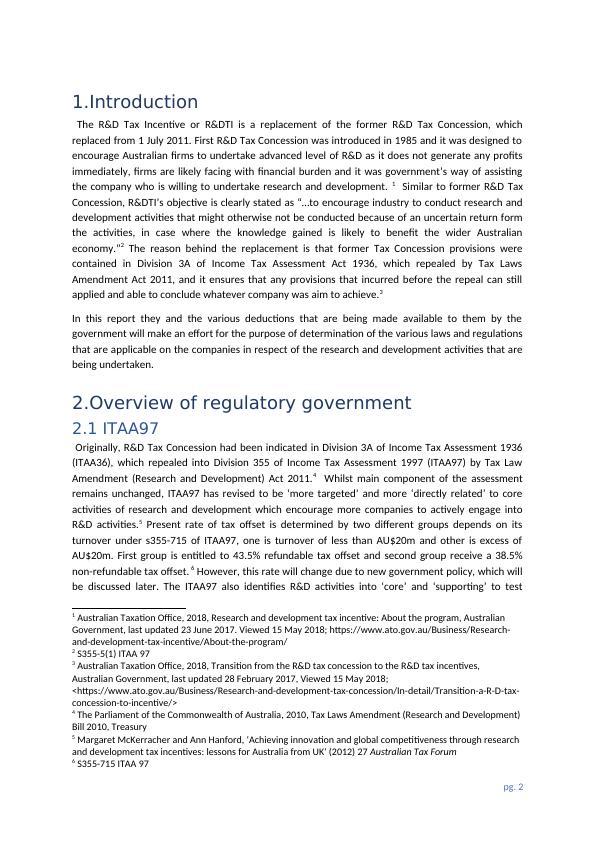The Implication of R&D Incentives Application to Small Business in Australia
Added on 2023-06-11
9 Pages3751 Words286 Views

Table of Contents
1.Introduction........................................................................................................................................2
2.Overview of regulatory government..................................................................................................2
2.1 ITAA97.........................................................................................................................................2
2.2 Tax Ruling....................................................................................................................................3
3.R&D and small business......................................................................................................................3
3.1 Overview......................................................................................................................................3
3.2 Effectiveness of Incentives...........................................................................................................3
3.3 Need for reform...........................................................................................................................3
3.4 Future direction...........................................................................................................................3
4.Conclusion..........................................................................................................................................3
5.Bibliography........................................................................................................................................4
pg. 1
1.Introduction........................................................................................................................................2
2.Overview of regulatory government..................................................................................................2
2.1 ITAA97.........................................................................................................................................2
2.2 Tax Ruling....................................................................................................................................3
3.R&D and small business......................................................................................................................3
3.1 Overview......................................................................................................................................3
3.2 Effectiveness of Incentives...........................................................................................................3
3.3 Need for reform...........................................................................................................................3
3.4 Future direction...........................................................................................................................3
4.Conclusion..........................................................................................................................................3
5.Bibliography........................................................................................................................................4
pg. 1

1.Introduction
The R&D Tax Incentive or R&DTI is a replacement of the former R&D Tax Concession, which
replaced from 1 July 2011. First R&D Tax Concession was introduced in 1985 and it was designed to
encourage Australian firms to undertake advanced level of R&D as it does not generate any profits
immediately, firms are likely facing with financial burden and it was government’s way of assisting
the company who is willing to undertake research and development. 1 Similar to former R&D Tax
Concession, R&DTI’s objective is clearly stated as “...to encourage industry to conduct research and
development activities that might otherwise not be conducted because of an uncertain return form
the activities, in case where the knowledge gained is likely to benefit the wider Australian
economy.”2 The reason behind the replacement is that former Tax Concession provisions were
contained in Division 3A of Income Tax Assessment Act 1936, which repealed by Tax Laws
Amendment Act 2011, and it ensures that any provisions that incurred before the repeal can still
applied and able to conclude whatever company was aim to achieve.3
In this report they and the various deductions that are being made available to them by the
government will make an effort for the purpose of determination of the various laws and regulations
that are applicable on the companies in respect of the research and development activities that are
being undertaken.
2.Overview of regulatory government
2.1 ITAA97
Originally, R&D Tax Concession had been indicated in Division 3A of Income Tax Assessment 1936
(ITAA36), which repealed into Division 355 of Income Tax Assessment 1997 (ITAA97) by Tax Law
Amendment (Research and Development) Act 2011.4 Whilst main component of the assessment
remains unchanged, ITAA97 has revised to be ‘more targeted’ and more ‘directly related’ to core
activities of research and development which encourage more companies to actively engage into
R&D activities.5 Present rate of tax offset is determined by two different groups depends on its
turnover under s355-715 of ITAA97, one is turnover of less than AU$20m and other is excess of
AU$20m. First group is entitled to 43.5% refundable tax offset and second group receive a 38.5%
non-refundable tax offset. 6 However, this rate will change due to new government policy, which will
be discussed later. The ITAA97 also identifies R&D activities into ‘core’ and ‘supporting’ to test
1 Australian Taxation Office, 2018, Research and development tax incentive: About the program, Australian
Government, last updated 23 June 2017. Viewed 15 May 2018; https://www.ato.gov.au/Business/Research-
and-development-tax-incentive/About-the-program/
2 S355-5(1) ITAA 97
3 Australian Taxation Office, 2018, Transition from the R&D tax concession to the R&D tax incentives,
Australian Government, last updated 28 February 2017, Viewed 15 May 2018;
<https://www.ato.gov.au/Business/Research-and-development-tax-concession/In-detail/Transition-a-R-D-tax-
concession-to-incentive/>
4 The Parliament of the Commonwealth of Australia, 2010, Tax Laws Amendment (Research and Development)
Bill 2010, Treasury
5 Margaret McKerracher and Ann Hanford, ‘Achieving innovation and global competitiveness through research
and development tax incentives: lessons for Australia from UK’ (2012) 27 Australian Tax Forum
6 S355-715 ITAA 97
pg. 2
The R&D Tax Incentive or R&DTI is a replacement of the former R&D Tax Concession, which
replaced from 1 July 2011. First R&D Tax Concession was introduced in 1985 and it was designed to
encourage Australian firms to undertake advanced level of R&D as it does not generate any profits
immediately, firms are likely facing with financial burden and it was government’s way of assisting
the company who is willing to undertake research and development. 1 Similar to former R&D Tax
Concession, R&DTI’s objective is clearly stated as “...to encourage industry to conduct research and
development activities that might otherwise not be conducted because of an uncertain return form
the activities, in case where the knowledge gained is likely to benefit the wider Australian
economy.”2 The reason behind the replacement is that former Tax Concession provisions were
contained in Division 3A of Income Tax Assessment Act 1936, which repealed by Tax Laws
Amendment Act 2011, and it ensures that any provisions that incurred before the repeal can still
applied and able to conclude whatever company was aim to achieve.3
In this report they and the various deductions that are being made available to them by the
government will make an effort for the purpose of determination of the various laws and regulations
that are applicable on the companies in respect of the research and development activities that are
being undertaken.
2.Overview of regulatory government
2.1 ITAA97
Originally, R&D Tax Concession had been indicated in Division 3A of Income Tax Assessment 1936
(ITAA36), which repealed into Division 355 of Income Tax Assessment 1997 (ITAA97) by Tax Law
Amendment (Research and Development) Act 2011.4 Whilst main component of the assessment
remains unchanged, ITAA97 has revised to be ‘more targeted’ and more ‘directly related’ to core
activities of research and development which encourage more companies to actively engage into
R&D activities.5 Present rate of tax offset is determined by two different groups depends on its
turnover under s355-715 of ITAA97, one is turnover of less than AU$20m and other is excess of
AU$20m. First group is entitled to 43.5% refundable tax offset and second group receive a 38.5%
non-refundable tax offset. 6 However, this rate will change due to new government policy, which will
be discussed later. The ITAA97 also identifies R&D activities into ‘core’ and ‘supporting’ to test
1 Australian Taxation Office, 2018, Research and development tax incentive: About the program, Australian
Government, last updated 23 June 2017. Viewed 15 May 2018; https://www.ato.gov.au/Business/Research-
and-development-tax-incentive/About-the-program/
2 S355-5(1) ITAA 97
3 Australian Taxation Office, 2018, Transition from the R&D tax concession to the R&D tax incentives,
Australian Government, last updated 28 February 2017, Viewed 15 May 2018;
<https://www.ato.gov.au/Business/Research-and-development-tax-concession/In-detail/Transition-a-R-D-tax-
concession-to-incentive/>
4 The Parliament of the Commonwealth of Australia, 2010, Tax Laws Amendment (Research and Development)
Bill 2010, Treasury
5 Margaret McKerracher and Ann Hanford, ‘Achieving innovation and global competitiveness through research
and development tax incentives: lessons for Australia from UK’ (2012) 27 Australian Tax Forum
6 S355-715 ITAA 97
pg. 2

End of preview
Want to access all the pages? Upload your documents or become a member.
Related Documents
Tax Implications of R&D Incentives in Small Businesseslg...
|10
|2826
|267
